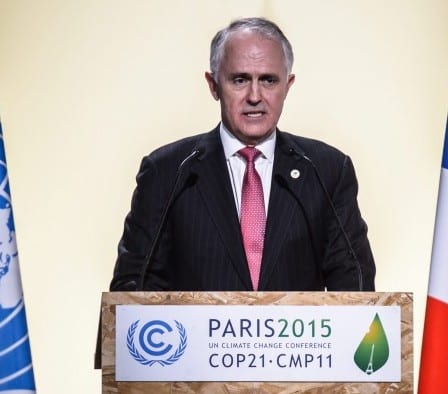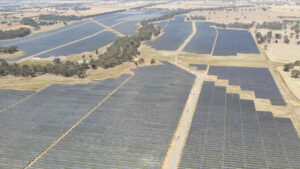(We issued this story on October 24, but reissue it now because of the confirmation from the ESB that it was directed to assume no emissions post 2030, and because the day we issues it access to our website was interrupted by a denial of service attack).
The Energy Security Board has been instructed to completely ignore Australia’s long term commitment to the Paris climate treaty, in yet another example of the extraordinary double speak that surrounds the Coalition’s latest climate policy thought bubble.
The ESB has been asked to present modelling to the COAG energy council within a few weeks, but in the letter sent by energy minister Josh Frydenberg, the ESB was told to restrict its modelling to only one specified short term target, and then assume emissions would “flatline” after that.
The intention of the order is clear: If the ESB were to factor in a long term target that matched the over-riding goal of the Paris climate treaty (keeping global warming well below 2°C), it would no doubt produce a document for the rapid decarbonisation of Australia’s grid.
Such a scenario is clearly not tenable to the considerable political and corporate forces that now dominate the debate, despite the numerous findings by the likes of CSIRO, Energy Networks Australia and transmission group Transgrid that this is both feasible and affordable.
Indeed, as Professor Ross garnaut said in his response to the Finkel Review, it was clear from the modelling undertaken that a larger amount of renewable energy – in response to higher targets – would result in much lower prices.
Instead, the public is being primed to think that a minimum effort might be tolerable, but only if incumbent assets – the grid coal generators and gas plants – are protected against the impacts of new technologies, which are being painted as a security threat and an added cost.
This is contrary to nearly all independent analysis, but the fear is that this will a policy designed by and for the incumbent energy lobby deepened on Monday with the news that the Business Council of Australia was offering itself as a “broker” to negotiations between the Coalition and the Labor Opposition.
“The Business Council believes this plan provides the best chance to break the deadlock on climate policy that has paralysed large-scale investment in dispatchable electricity generation for several years,” it said in a letter governments.
“The Business Council’s member companies include many of the nation’s major electricity users, generators and retailers. If requested, we would gladly coordinate and convene meetings with those members.”
It’s an extraordinary proposal. As the letter notes, the BCA membership includes the major energy utilities, is chaired by former Origin Energy boss Grant King, and its former policy chief Clare Savage now sits on the board of the ESB as deputy chair.
The influence of lobbyist on the political process is well known, but normally efforts are made to at least make it appear at arms length, even though the incumbents have fought ferociously to protect their dominance of the industry and limit competition.
Now, it appears, policy design is to be outsourced to the industry.
Greens leader Senator Richard diNatale said he was appalled by the “gall” of the BCA, who had “led the charge on behalf of Tony Abbott” to tear down Australia’s world-leading carbon price.
“We need to fix our broken political system. We need to rid it of big corporate donations and the corrupt revolving door between politicians and powerful board rooms. Only then will we see real action on climate change from the government.
“The Business Council of Australia is at the heart of this rotten problem. Their energy adviser moves straight to the Energy Security Board to help write the government’s new National Energy Guarantee policy.
“Is it any wonder this policy is focused on keep coal fired power stations open longer, at the cost of driving 21st century investment and securing a liveable planet for our grandkids.”
There was also further confirmation on Monday that the the NEG policy outline had been put together in just 10 days, as RenewEconomy reported last week.
The idea of the NEG was first raised with the government in September, just days after the ESB’s first meeting, and after a formal request from Frydenberg on October 3, the eight-page policy outline was delivered on October 13.
Frydenberg and prime minister Malcolm Turnbull appear to have accepted it on the same day, signalling through the media that a new policy that would be presented to the Cabinet and party room days later.
The Coalition have defended the sparse details and concept of the scheme, saying that it was proposed by energy experts. But in the Senate estimates hearings on Monday, it was clear that the Clean Energy Regulator, the Climate Change Authority and the Australian Renewable Energy Agency were not told of the work.
The COAG energy council, which includes the state energy ministers and to which the ESB is supposed to report, was also deliberately kept in the dark.
The department of energy and environment confirmed that it had no modelling to support the claims made in the eight-page policy document, which appears to have plucked its numbers from thin air, and presented in a way that may appease conservative factions that had made the heavily modelled clean energy target impossible.
Those numbers, suggesting little or no new renewable energy over the next decade, a slight fall in consumer prices, and a emissions target to 2030 at the bottom end of expectations appear designed to achieve a political outcome. The fear is now that the policy will be designed to fit those numbers.
That certainly seems to be the intent with the Treasurer’s instructions to the ESB. It has asked the ESB to factor in variables in renewable energy costs, variability in demand, in gas prices, and if Snowy 2.0 is built.
It is also asked model a target reached in a linear fashion, or back-ended so any reductions actually only occur a decade from now. But it is specifically instructed to ignore any different emissions targets out to 2030 and to assume “constant” emissions after that.
“The modelling should also assume a constant target post-2030,” the Frydenberg letter says.
Ironically, the ESB’s own charter actually excludes it from considering emissions – despite its work on the NEG, and its insistence that it combine both a reliability guarantee and an emissions guarantee.
It is difficult to understand how the ESB it can frame a credible policy that does not allow for climate policies that actually reflect the long term Paris goals.
Already, one of the main criticisms of the NEG is that it may not be scaleable because it locks in so much coal and gas generation, and cements the control of established utilities.
But the political battleground seems destined to be fought on prices. The Coalition’s base position is that any amount of renewable energy will increases prices, an argument it is prosecuting relentlessly through the Murdoch media, first with tall tales of the cost of renewable incentives, and on Tuesday with the assumed cost of a 50 per cent renewable energy target.
The Australian – citing modelling from the government that Frydenberg’s office refused to share with Reneweconomy, claimed extra costs of renewables would be $200 a year, compared to the claimed $100 cut from the NEG, which has not been modelled.
Labor created with disdain, and climate spokesman Mark Butler said the story assumed that an EIS (which is no longer Labor policy anyway) would be internationally linked and would start with a carbon price of $69 per tonne of carbon in 2020.
He said most modelling – from the CSIRO, AEMC and others – showed that an EIS would be up to $15 billion lower over the course of the next decade.
Garnaut, the eminent economist who spent considerably longer than 10 days producing the Garnaut Review, said that the Jacobs modelling cited by the Coalition and The Australian actually showed prices falling by a large amount under the Emissions Intensity Scheme, and more under the Clean Energy Target.”
“In my view, the new energy technologies will be a path to decisive reversal of the relentless and immense increase in electricity prices over the past dozen years,” Garnaut said in a recent speech.
“Moving onto a steeper emissions reduction path …. will drive down wholesale electricity prices, not only to lower levels than they are at present, but to prices that are notably low by global standards.
“No other developed country has anything like the renewable energy resource endowment per person that is enjoyed by Australia. If we get our policy right, as the whole world moves towards low emissions energy, we will emerge as the developed country with the lowest electricity costs.”
But all of this is out of bounds for the ESB, and the question is now how it could possibly frame a policy without a long term target, considering that it is dealing with long dated assets, and at a time of rapid technology change.
Even the kindest analysis for the NEG, from Bloomberg New Energy Finance, noted that the scheme fell short on emissions targets, would likely increase rather than reduce prices, would lock in the power of the incumbents, and probably wasn’t scaleable to more ambitious climate targets in any case.
One of the biggest criticisms of Australia’s energy market has been that its objectives, included in a document known as the NEO (National Energy Objectives specifically exclude any consideration of climate change, emissions or the environment.
This has results in the principal rule maker ignoring those factors and act as a void, with consideration only to “price, reliability and security” – the first of which it has patently failed.











